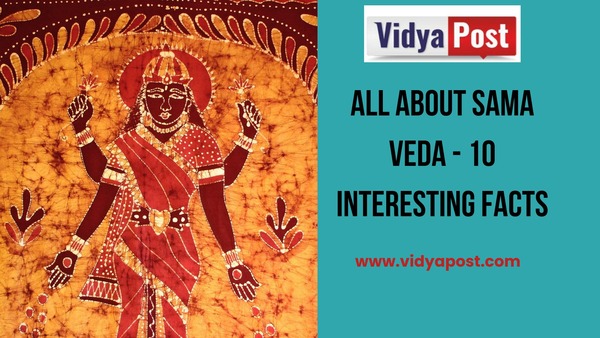ALL ABOUT SAMA VEDA - 10 INTERESTING FACTS

In this article, we will delve into the fascinating world of the Sama Veda and uncover 10 interesting facts about this ancient scripture. From its history and composition to its significance in Hinduism, we will explore all aspects of the Sama Veda in this comprehensive guide.
Also, Read Best courses you can pursue after 12th
1. Shortest of All The Four
The Sama Veda is the shortest of the four Vedas and is closely related to the Rigveda. Many of the verses in the Sama Veda are taken from the eighth and ninth mandalas of the Rigveda. It consists of 1875 verses in total out of which 1771 of the verses are from the Rigveda, while the remaining 99 are considered to be original to the Sama Veda. This connection between the Sama Veda and the Rigveda highlights the significance of the Sama Veda in the Hindu scriptures.
2. Historicity of Sama Veda
Micheal Witzel estimates the composition of the Sama Veda text to have taken place after the composition of Rigveda and in the range of 1200 to 1000 BCE, which makes it contemporary with the Atharvaveda and Yajurveda. There were around a dozen styles of chanting the Sama Veda and of the three surviving versions, the Jaiminiya is believed to preserve the oldest tradition of Samavedic chanting.
3. Meaning of Sama Veda
The Sama Veda is a collection of hymns that were sung during religious rituals and worship of gods. The word 'Sama' means 'song' and the mantras in the Sama Veda are written in the form of a complete Vedic song. The hymns were mainly sung by the Udagatr priest during the Soma sacrifice and are considered to be the foremost among the four Vedas. The hymns are meant to praise the gods, mainly Indra, Agni, and Soma, and can be interpreted as prayers to the Supreme Being. The chanting of these hymns is believed to have a spiritual significance, representing devotion and worship (Upasana).
4. Division of Sama Veda
The Sama Veda is divided into two parts: the Archika and the Gana. The Archika is further divided into the Purvarcika and the Uttararcika, and The Gana part of the Sama Veda is divided into Prakrti Gana and Uha Gana, with the Uha Gana being an application of the Samans from the Prakrti Gana.
5. Main Deity in the Sama Veda
The main deity of the Sama Veda is the Sun God, Surya or Savitra, and the hymns in this scripture are mainly dedicated to praising and worshiping this deity. However, there is also an adequate representation of other gods such as Indra and Soma in the Sama Veda. The hymns were sung during the soma sacrifice, which was a significant ritual in ancient Vedic religion. The Sama Veda is considered to be one of the most important scriptures for understanding the ancient Vedic system and its beliefs about the divine and the role of the Sun God in the cosmos.
6. Purpose of Sama Veda
The primary purpose of the Sama Veda is to be used in rituals and ceremonies. The verses in the Sama Veda are meant to be chanted at the Soma sacrifice and other related rituals. The Sama Veda is specifically designed for the Udagatr priest, and its verses take on a musical form in various song-books called Ganas. This emphasizes the importance of chanting and music in the Hindu religion.
7. Theme of Sama Veda
The major theme of the Sama Veda can be described as worship and devotion (Upasana). Bhagavad Gita quotes Shri Krishna as saying that he is Samveda among the four holy Vedas. The Sama Veda invokes and praises the deities of Indra, Agni, and Soma but also seems to be an invocation for the Supreme Being. Soma represents the All-pervading, Glorious Lord and Brahman, which can be attained through devotion and musical chanting of Samveda.
8. Origin of Sa-Re-Ga-Ma
The Narad Shastra, an ancient text on education, describes the system of singing the Sama Veda in India, which is known as the sa-re-ga-ma-pa-da-ni-sa system in modern Hindustani and Carnatic music. The seven musical notes are:
Shadaj - Sa
Rishabh - Re
Gandhar - Ga
Madhyam - Ma
Pancham - Pa
Dhaivat - Dha
Nishad - Ni.
9. Mention of Modern Musical Instruments
The Ancient Indian musical instruments mentioned in the Vedic era:
-
String instruments: Kannada Veena, Kaccheri Veena, and Veena
-
Percussion instruments: Dounduvi, Aadanbar within the heavy musical instruments category
-
Wind instruments: Turabi, Nadhi, and Bunkura among the Vanshi (flute) category
The name of some musical instruments mentioned in the Sama Veda, such as the "Mridang" drum, are still in use today. The term "vanshi" for flute is also mentioned in the Sama Veda. The above-mentioned musical instruments hold significant importance in ancient Indian musical history and continue to be an integral part of Indian classical music even today.
10. Rigveda and Sama Veda
The Sama Veda, one of the four ancient Hindu scriptures, is considered less important than the Rigveda, due to the repetition of the majority of its verses found in the Rigveda. As told earlier, the majority of hymns found in Sama Veda can be found in Rigveda and only 75 verses of the Sama Veda contain original content, making the study of the Rigveda sufficient for understanding the Hindu religious text.
Also, Read All about AIU
Book - Shāstra’ by Saskia Rao de-Haas - https://www.theaustraliatoday.com.au/shastra-by-saskia-rao-de-haas-chronicles-indian-music-history-from-5000-bc/
https://vedicheritage.gov.in/samhitas/samaveda-samhitas/
Worship of Nada Brahman by T.S. PARTHASARATHY - https://www.indiaforums.com/forum/topic/308539
https://sites.harvard.edu/witzel/
Share:

2 Comments
Jordan Singer
2d2 replies
Santiago Roberts
4d